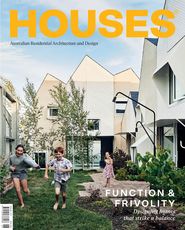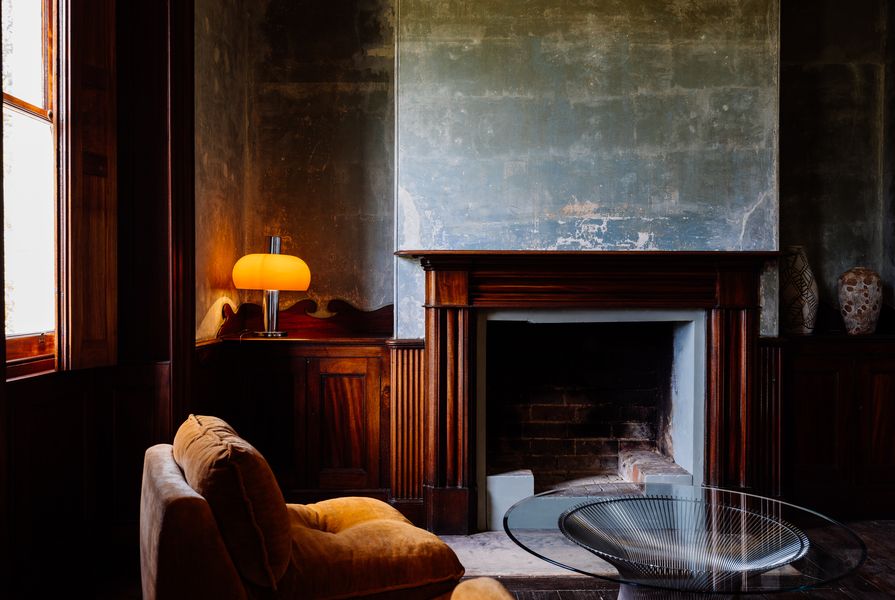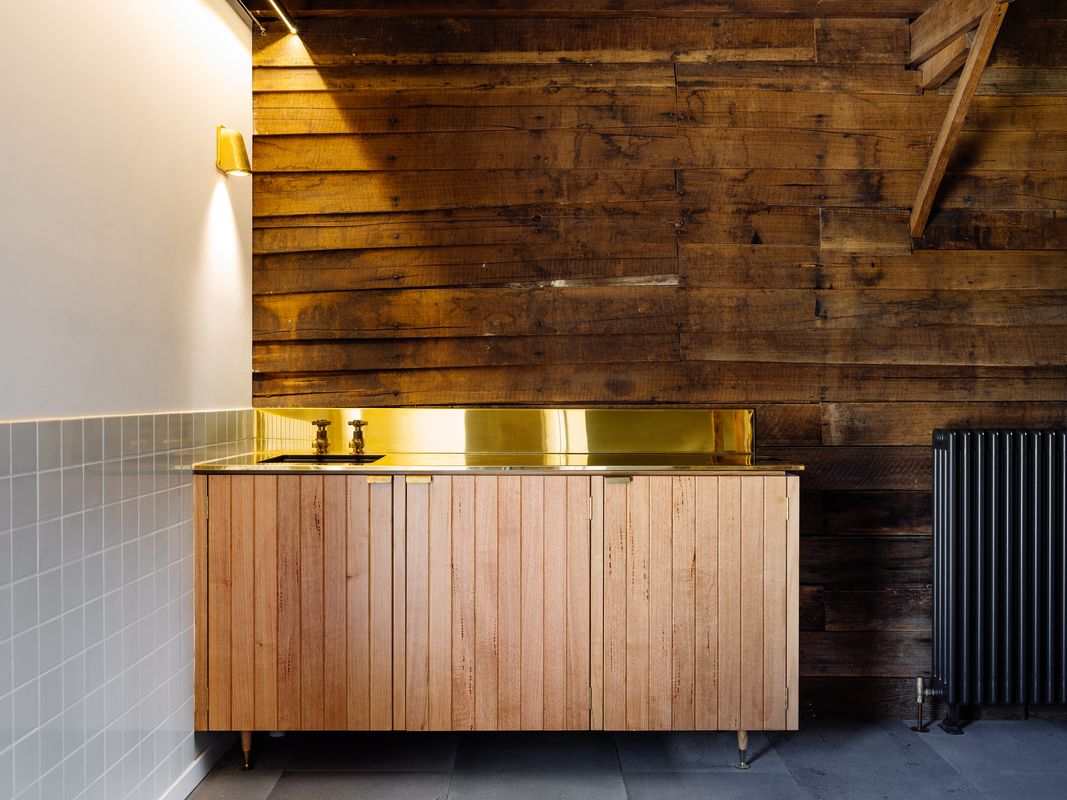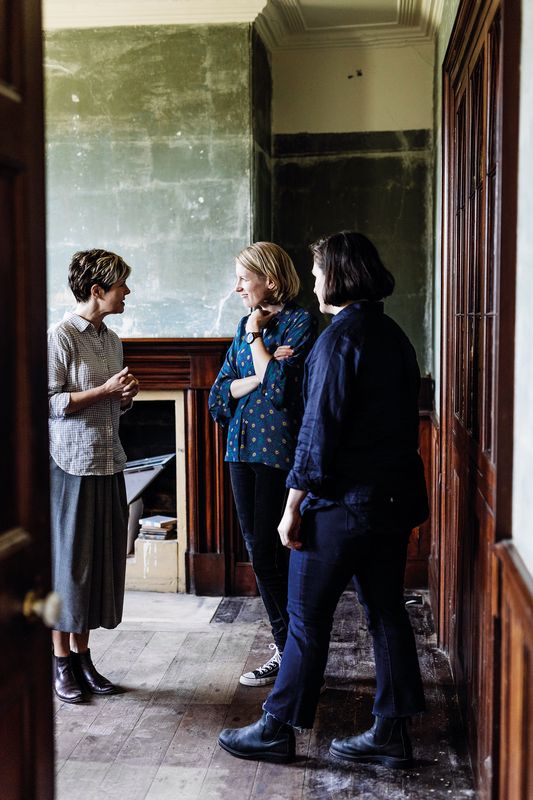Stephanie McGann: Could you tell us a little about yourself and what drew you to this historic property in Tasmania’s Central Highlands?
Harriett England: My husband and I have always loved Tasmania and have spent a lot of time down here. We were based in Sydney and found ourselves migrating further and further south because three of our five children were living in Melbourne and we actually owned an apartment in Hobart. Just three weeks after selling that apartment, I saw an ad for this property, Strathborough in Hollow Tree, and I said: “I’m having Tassie withdrawal symptoms – we should go take a look at this house.” We flew down for a week and went out to the property, and we asked Ryan Strating [founding director of Core Collective Architects] to visit it, too. He spent a whole afternoon climbing the hill, taking photographs, and said it sounded like a great project, so we made an offer on the house and were lucky enough to get it! It’s a beautiful environment in sheep country, with farmers growing other crops and poppies around us. It’s just a really special place in a little bit of a hollow and it’s idyllic.
SM: So you were familiar with Ryan and the team at Core Collective Architects. What led you to engage an architect?
HE: Although we were familiar with Ryan’s work – we enjoyed dining at Franklin in Hobart and really liked what he’d created with that – the fact that we got on so well with him was an equally important factor in why we asked him to be involved. We met Ryan at an art show a few years ago and we’ve become friends. I think it’s important to have a relationship with your architect where you feel free to say exactly what you think, and this was a very natural relationship where we knew we could just work really easily together.
Homeowner Harriett is now good friends with the architects and building team.
Image: Adam Gibson
SM: What was your brief to Core Collective Architects for this project?
HE: It was always going to be our home and we wanted to get it back, as close as possible, to its original form. But we also wanted it to be a comfortable house to live in. A lot had been added to it over many years, and there were elements from different periods that we had to retain and somehow get to work together better. We thought: Let’s just take this back and treat it sympathetically. Let’s not do anything we don’t have to until we’re at the point where it’s absolutely necessary. And let’s really consider the best ways to do these things.
We also had an idea that we had been thinking about for some years in that we wanted to share and celebrate the work of Australian Indigenous artists for whom we have huge respect. This area in central Tasmania was one of great conflict and confrontation between the Aboriginal people and colonizers. We wanted to bring Indigenous art into this place, into this colonial Georgian shell, and to reintroduce the Indigenous trees and plants that would have grown in the area long ago.
SM: What was it like to work not only with an architect but also with a heritage consultant and a builder?
HE: A bit of a juggling act! Ryan had worked with our builder, Dave Davenport, before and they had a good relationship. Brad Williams, our heritage consultant, was vital to the project and helped us peel back the layers to try to figure out how the house had originally been built. We would workshop solutions to things and nobody’s opinion was more valid than the others. It was a lovely team effort.
SM: It sounds like you really enjoyed this process.
HE: Very much! And we’ve remained very good friends, too. Not only with Ryan but the builders and the heritage consultant, and really everyone who worked here. It’s been very much an open-house policy – more so than I expected because it’s a lovely community here and people driving past would pop in to have a look.
Hollow Tree House is etched with a kaleidoscope of stories, retained in Core Collective Architects’ design.
Image: Adam Gibson
SM: What are some of your highlights from the process of investigation and design of this historic house?
HE: It was very much a slow, archaeological process. For instance, every room in the house had been wallpapered during a long period of its history in which it was tenanted, and many of the walls weren’t in great shape. So, one of our first thoughts was to use a plain wallpaper and to apply the original paint colours to it. But as we peeled back layers of wallpaper from the ’30s, ’60s, ’70s and so on, and we saw that everyone – from the first person who had wallpapered it – had signed it and kids had written things all over the wall, it seemed such a pity to cover all that up. We ended up having a discussion as a team and I said: “I really love these walls and they say so much about the history of this place.” So, we left most of the walls as we’d discovered them under the paper. We were working with Heritage Tasmania, who don’t necessarily believe that things should be taken right back to scratch. They very much believe in layers – it’s just a question of which layers to leave. And that can be a particularly tricky decision to make, especially when the house is a couple of hundred years old and you’ve had a series of people living there who have left their marks, both beautiful and less so.
SM: What advice would you give someone who was thinking about engaging an architect?
HE: Don’t just look at their past work. If it’s going to be a long process – and it so often is, and it can be very stressful if it’s taking time – make sure that you really get on with the architect, that you like the person, the team. Because that’s what has made this project a joy. It really is a team effort – all the best things in life are, to me.
Read more about Hollow Tree House here.
Source

People
Published online: 9 Apr 2021
Words:
Stephanie McGann
Images:
Adam Gibson
Issue
Houses, December 2020






















